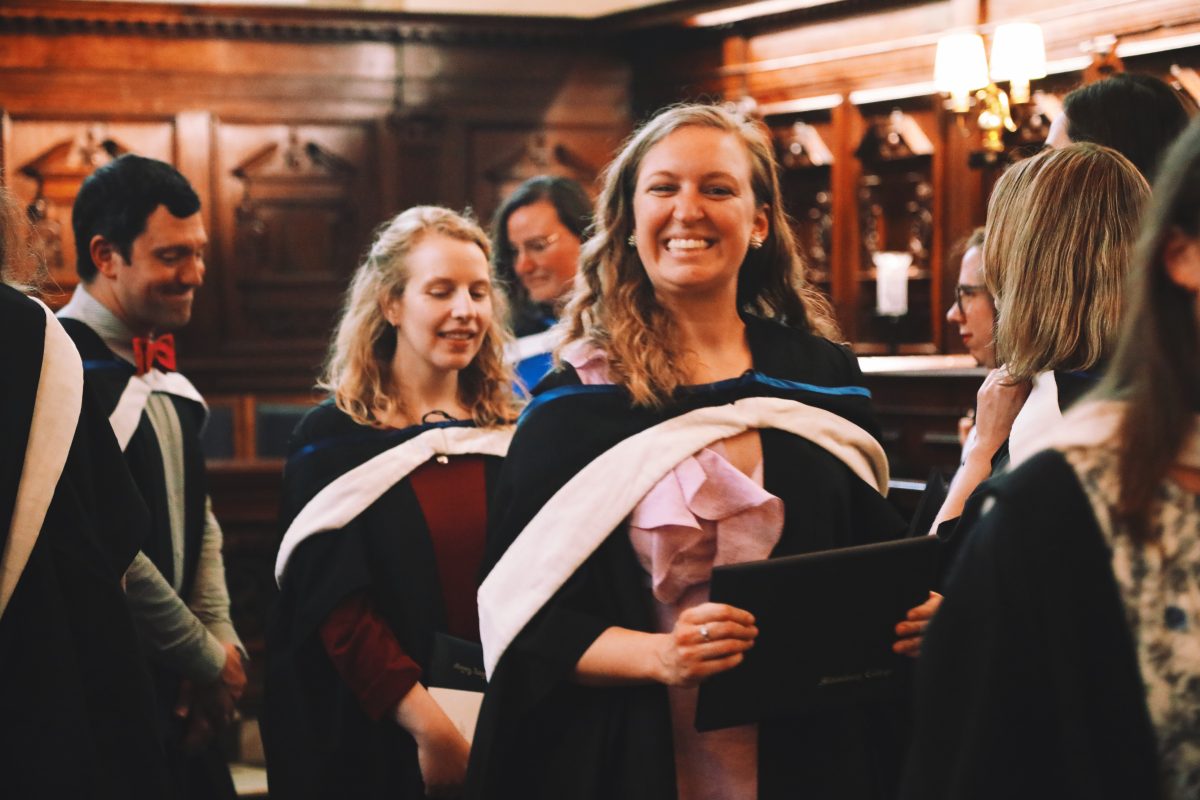The tension in the room is palpable as the votes are counted. Emily Gossett (’16) awaits the results with trepidation: Will this be the moment she has spent the last two years dreaming about or will it be the nightmare that has plagued her dreams for the last few weeks?
When the verdict is finally announced, Gossett has won and Student Council (StuCo), has a new president.
The small group of her friends that has stayed through the afternoon’s proceedings get what they came for and StuCo members stand in applause.
The shaking legs and beating heart are out of her control, but the hint of a smile is playing at the corners of her lips. Her emotions threaten to bubble over but her face remains composed: There is work to be done.
“I could say that I am terrified but I’m actually really excited,” Gossett said. “I’ve felt like I could do this for a long time now and I feel like, for the junior grade itself, this is a role I already play. [Now], I am ready to take on the school.”
The future of an organization – if not the voice of the student body – is now in the hands of President Gossett, Vice President Jed Alberts (’16), and the rest of their Council.
They have big shoes to fill, or at least that’s how former Vice President Dariush Yazdanpanah (’15) sees it. “I hope that next year’s [StuCo] doesn’t stand still and that it moves away from this year of transition with a new administration and continues to bring fresh ideas to the table,” he said. “I feel that this group has a high level of motivation and creativity to help develop our community… and I wouldn’t want this strong level of enthusiasm to waver.”
While Gossett understands the expectations, she is confident that her – the simple pronoun still elicits the hint of a smile – StuCo, is more than capable.
In her mind StuCo will be, and to her knowledge always has been, successful; it is the definition of success, rather, that creates the negative perceptions. “I don’t really know how you can measure effectiveness. It is really hard to finish a lot of initiatives that we start; it can take a year, almost two years,” she said. “I think a lot of students feel as though that is a long time and that something so simple shouldn’t take that long. The student body doesn’t think we are effective but I don’t think they understand how hard it is to have our say, and for the administration to take our initiatives and make them real.”
In the new era of StuCo leadership, the question over what role StuCo plays within the High School is at the forefront of their young identity.
Student Council Advisor Tony Bracht believes that the Council plays an integral role in every piece of the school that involves student voice. “[StuCo is] the primary conduit for student voice and student leadership when it comes to the running of the school; they have direct contact with the Board [of Trustees], they have direct contact with the Principal, [and] the Director of Student Life,” he said.
Gossett’s first goals will be largely internal, as she wishes to create and maintain a level of professional communication and organization. However, the ultimate goal that she will look to fulfill during her term as president is, “to integrate the High School as one, not divided by grades or [by any other means]. What we did with the junior year this year, bringing them together through the grade-wide lock-in [and other events], that is what I want for the entire High School,” she said.
For Gossett, clarity regarding what StuCo does and how they go about their business is of utmost importance. Especially at a school where she feels the Council’s role is currently taken less seriously than it should be. “For the amount of work we put in – the hours we put in – the amount of times I’ve heard ‘what does StuCo do?’ It makes you feel like you have been running on a treadmill but have gotten nowhere,” she said. “You work really, really hard, for the benefit of your classmates, and people don’t really notice.”
For Andrew Skow (’17), who next year will run for his second term on the council, being part of StuCo has a personal implication stemming from his “deep respect” for the school. “I feel like I have a duty to give back to the institution that educated me and will bring me to where I am going to eventually be, hopefully as a successful adult,” he said. “Being on [StuCo] is a little way to start that giving back process.”
Skow can see how StuCo can be misconstrued – as it often is by the student body – as an organization that does very little within the school. However, for him, like Gossett, that is a false representation. “A lot of the things we do are little [things] that aren’t really noticeable. For example we do a lot with the cafeteria and the cafeteria staff, it might not lead anywhere, but we do have meetings with these different groups around the school to find out what’s going on[StuCo] has a very good idea about what is going on in the school… but we internalize that information.”
But where does the power to create real, tangible change factor in? Skow would describe StuCo as having “influence” and is hesitant to use the word “power”. The difference between the two being, “power is the actual ability to make a change, personally, by yourself; [StuCo] does not have that power,” he said. “We have influence on all the administrative bodies. We can speak with [them] and tell them the problems that we reached and how we would like to see them changed, but ultimately it is their decision and they have the power to make these decisions.”
Regardless, Skow believes StuCo serves an important role in that, “we do have an ear, and I think that can go a long way.”
The now-former President Celia Mitchell (’15) provides a different perspective. She believes that this year’s lack of tangible change was not due to a lack of power, but rather that it was a year of transition – a “new start” for the Council to work with the fresh administration.
Not only were they faced with an administration that they were unaccustomed to, but Mitchell highlights a year centered on brainstorming for future, long-term plans as another reason for the lack of current change.
While passionate, Gossett does not seem optimistic about the level of power StuCo is entrusted with. “I would love to say that we have power, but I’m not really sure if we do,” she said. “I feel as though student voice has always been something… that ASL [encourages], but I don’t always feel like our voice is heard.”
Director of Student of Life James Perry believes that this “power” is achieved by StuCo being able to advocate for “every single high school student.”
And, while Perry wouldn’t use the word “power” when describing StuCo’s ability to create change, he does believe StuCo is dilligent in that, “they work hard and usually execute all of the proposals that they bring to the table.”
In Lucas Pabarcius’ (’18) experience, the problem isn’t StuCo’s power, it is the current way of implementing change that he finds inefficient. “We’ll have lots of discussion but many of our proposals can’t go into effect because it’s very difficult to actually change things, it requires lots of shifting through different people in the administration,” he said.
Pabarcius cites the new mandate for teachers to publish grades on Haiku as an example of the bureaucratic nature of StuCo’s work with the administration – the process lasting almost four months due to the many steps and discussions that came with it.
It is a process, Gossett has described only half-jokingly, where, “It’s almost like you have to go through a million people to move an arm at this school.”
The time and effort it takes StuCo to implement change, whether tangible or not, Pabarcius believes, is one reason why many members of the student body criticize the Council for “doing nothing.”
The extensive timeline of StuCo proposals is not the only limitation that Pabarcius highlights. A factor that, in his eyes, holds them back even more is that “sometimes there’s an ignorance in the administration of our ideas.”
This year, when StuCo tried to bring juice back to the cafeteria in accordance with popular opinion, a significant amount of time was spent researching before eventually, the Council made a proposal to Head of School Coreen Hester. “Beyond our proposal, we haven’t heard much back,” Pabarcius said. “There’s very little communication once we propose something… we’re either told that it will not go into place or, what happens even more often, is that there is no carrying through [or response by the Administration].”
Alberts agrees with Pabarcius that the Council will face restrictions in going through with proposals, but that it should not hinder members’ motivation. “Obviously there’s going to be limitations [to StuCo’s power] but that doesn’t mean that we can’t try with whatever it is we’ll be trying.”
Gossett does acknowledge that a lack of tangible change brought about by a hesitant administration or the lengthy timelines necessary for initiatives can place StuCo in a seemingly passive position in the eyes of the student body. However, she firmly believes transparency is not an issue.
This argument about a lack of transparency – which StuCo has been repeatedly criticized for – carries no weight with Gossett. “I feel like we work hard to make our initiatives public. We always mention that we have our Haiku page, where every week we have our minutes up there and the initiatives that we are taking,” she said. “You can literally go through and read our minutes and therefore know exactly what every [council member] knows about what happened in that room when they walk out of the meeting. If people don’t feel like we inform them, I’m a little insulted by that because we do make it very clear.”
Despite this, Gossett does have plans to improve communication for next year, citing a StuCo snapchat account, a suggestion box on haiku and more frequent blogs as necessary components. “Communication is something entirely within our power and so our goal is to be completely transparent,” Gosset said. “After all, without communication how can we say we represent the student body?”







